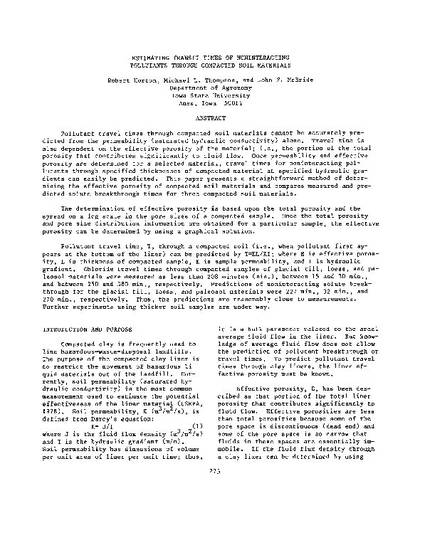
Pollutant travel times through compacted soil materials cannot be accurately predicted from the permeability (saturated hydraulic conductivity) alone, Travel time is also dependent on the effective porosity of the material; i.e., the portion of the total porosity that contributes significantly to fluid flow. Once permeability and effective porosity are determined for a selected material, travel times for noninteracting pollutants through specified thicknesses of compacted material at specified hydraulic gradients can easily be predicted. This paper presents a straightforward method of determining the effective porosity of compacted soil materials and compares measured and predicted solute breakthrough times for three compacted soil materials,
The determination of effective porosity is based upon the total porosity and the spread on a log scale in the pore sizes of a compacted sample, Once the total porosity and pore size distribution information are obtained for a particular sample, the effective porosity can be determined by using a graphical solution.
Pollutant travel time, T, through a compacted soil (i.e., when pollutant first appears at the bottom of the liner) can be predicted by T=EL/KI; where E is effective porosity, L is thickness of compacted sample, K is sample permeability, and I is hydraulic gradient. Chloride travel times through compacted samples of glacial till, loess, and paleosol materials were measured as less than 208 minutes (min.), between 15 and 30 min., and between 250 and 380 min., respectively. Predictions of noninteracting solute breakthrough for the glacial till, loess, and paleosol materials were 227 min., 32 min., and 270 min., respectively. Thus, the predictions are reasonably close to measurements. Further experiments using thicker soil samples are under way.
Available at: http://works.bepress.com/robert-horton/21/

This proceeding was published as Horton, R., M. L. Thompson, and J. F. McBride. 1985. Estimating transit times of noninteracting pollutants through compacted soil materials. Land Disposal of Hazardous Waste: Proceedings of the Eleventh Annual Solid Waste Research Symposium: 275-282.